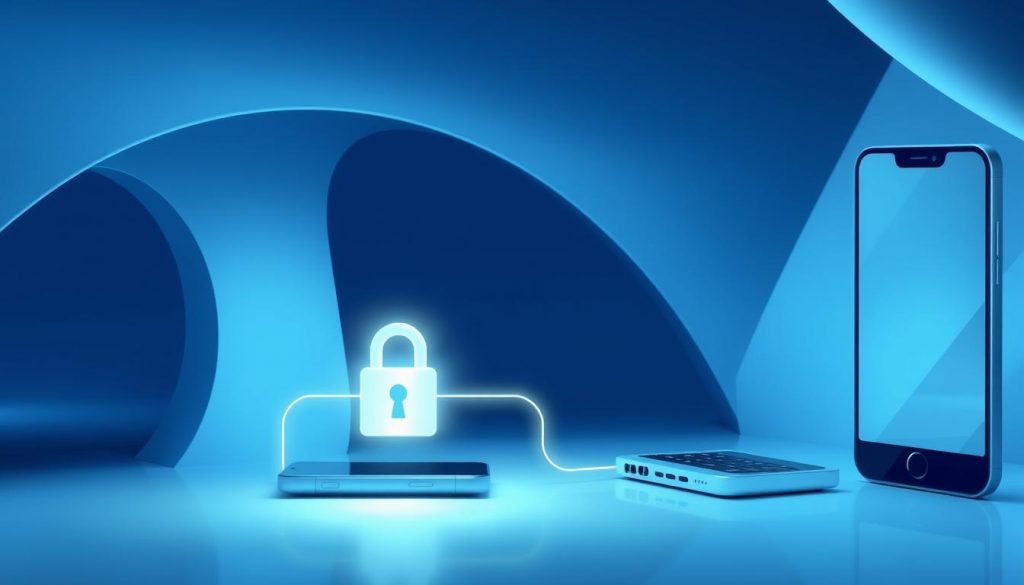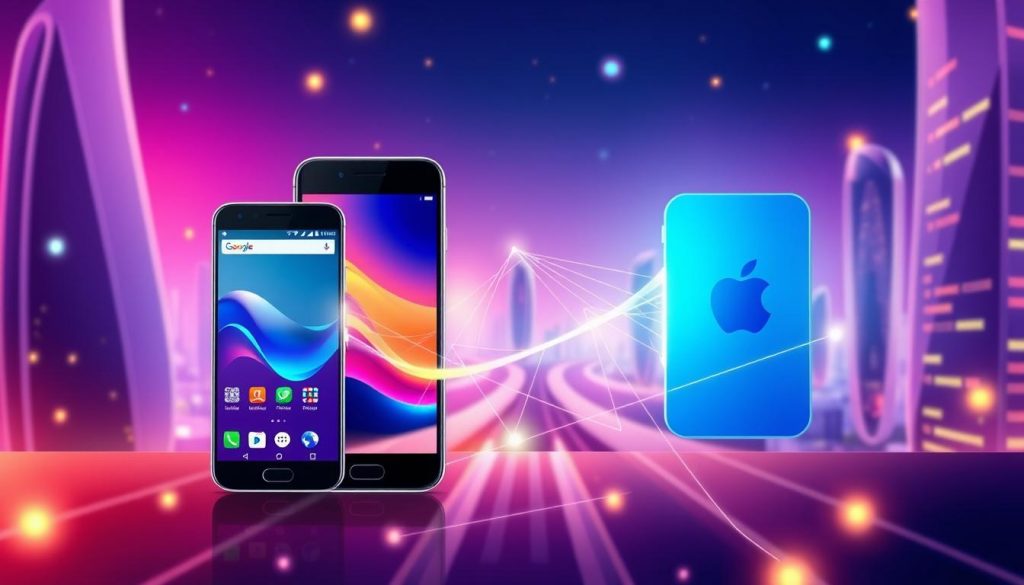Have you ever found yourself struggling to send a photo to a friend because they use a different phone system? For years, this digital divide has frustrated millions. What if the walls between mobile ecosystems finally started to crumble?
In a surprising move, Google announced a significant shift on 20th November 2025. Their popular sharing feature received a major update. This development bridges a long-standing gap between rival operating systems.
The new implementation allows seamless transfers between previously incompatible devices. Users can now exchange photos, videos, and documents effortlessly. This change represents a huge step forward in cross-platform compatibility.
Initially available on Google’s latest Pixel 10 lineup, the functionality will expand to other models. This addresses a common user pain point with a practical solution. The tech community has enthusiastically welcomed this collaborative approach.
Key Takeaways
- Google’s announcement marks a pivotal moment for interoperability between mobile platforms.
- The feature enables direct file transfers between Android and Apple devices without compatibility concerns.
- The initial rollout focuses on Pixel 10 devices, with plans for broader availability across other models.
- This development simplifies daily digital interactions for users across different ecosystems.
- The update reflects growing industry emphasis on user convenience over platform exclusivity.
- Secure sharing remains a priority in this cross-platform implementation.
What’s New: Quick Share Meets AirDrop
Imagine transferring holiday photos to relatives without worrying about their device preferences. Google’s innovation achieves precisely this convenience.
The breakthrough centres on temporary discoverability settings. iPhone owners must enable a specific mode to initiate cross-platform exchanges.
This functionality operates through a simple two-step process. First, Apple device users activate the “Everyone for 10 minutes” setting. This makes their gadget visible to nearby devices temporarily.
Pixel owners can then detect available iPhones within their sharing interface. They select the desired recipient and begin transferring photos or documents.
The system supports bidirectional communication. iPhones can similarly send files to Pixels when both devices have discoverability enabled.
Google describes this development as an initial phase. The tech company aims to expand compatibility with more restrictive privacy settings in future updates.
For the latest breakthroughs, see our Technology page.
| Device Role | Required Action | Transfer Capability |
|---|---|---|
| iPhone Users | Enable “Everyone 10 minutes” mode | Receive and send files |
| Pixel Users | Open the Quick Share interface | Detect and initiate transfers |
| Both Devices | Maintain proximity | Two-way file exchange |
This approach maintains security through time-limited visibility. The temporary nature of the mode addresses potential privacy concerns effectively.
Households with mixed device ecosystems benefit particularly. Families can now share memories without compatibility barriers.
The feature reflects Google’s philosophy about connecting people through technology. It demonstrates how practical solutions can bridge digital divides.
How Android Quick Share Now Works With Apple’s AirDrop
Understanding the technical implementation reveals how this cross-platform magic operates. The system functions through direct device-to-device communication rather than server mediation.

Discoverability Requirements and Transfer Process
Apple users must first adjust their settings to enable cross-platform sharing. They select the “Everyone for 10 minutes” option within their sharing preferences.
This temporary visibility window allows nearby gadgets to detect their presence. Pixel owners can then see available iPhones within their sharing interface.
The transfer initiation appears as a standard request on both screens. Users verify the recipient’s name before confirming the exchange.
This careful verification process prevents accidental transfers to the wrong devices. It maintains the security standards both platforms demand.
Security Implementation and Peer-to-Peer Architecture
Google engineered this solution without resorting to any server-based workarounds. The connection is established directly between devices using peer-to-peer technology.
All transferred information remains entirely local during the process. No data passes through external servers or gets logged anywhere.
The development team utilised the Rust programming language for implementation. This choice eliminates memory-safety vulnerabilities that could compromise security.
Independent security firms like NetSPI conducted penetration testing. Their validation ensures robust protection against potential exploits.
One security expert noted:
“This architecture represents best practices in cross-platform security implementation. The local-only data transfer model significantly reduces privacy concerns.”
This approach maintains the efficiency of both systems. Users experience the same speed and reliability they expect from native sharing.
The technical achievement demonstrates Google’s commitment to user convenience. It addresses enterprise concerns about data protection across platforms.
Why This Cross-Platform Breakthrough Matters
Businesses and families alike stand to benefit from this breakthrough in mobile interoperability. The development represents more than just technical convenience—it signals a fundamental shift in how technology companies approach ecosystem boundaries.
Breaking Down Ecosystem Barriers
For years, mobile operating systems maintained strict digital divides. Users faced frustration when attempting basic file exchanges between different platforms.
This new implementation completely changes that dynamic. It enables seamless communication where previously there were only barriers.
Read the full report at The Verge.

The feature works through a clever technical approach that maintains security while enabling compatibility. Users activate the appropriate mode to begin sharing.
This represents a significant step toward proper digital integration. It demonstrates how practical solutions can overcome longstanding technical challenges.
Google’s Independent Achievement Without Apple’s Collaboration
Remarkably, Google accomplished this interoperability without Apple’s direct involvement. The company developed the entire implementation independently.
This independent development showcases Google’s technical capabilities. It proves that cross-platform compatibility can be achieved through unilateral innovation.
The feature’s architecture uses peer-to-peer connections that bypass server requirements. This approach maintains the security standards both platforms demand.
One industry analyst noted:
“Google’s independent achievement demonstrates that ecosystem walls can be breached through technical ingenuity rather than corporate negotiation.”
Potential Impact on Mobile Device Management Policies
Enterprise mobile management is poised for transformation due to this development. Many organisations previously disabled sharing features due to security concerns.
The validated secure implementation offers new possibilities for business use. Companies might reconsider their policies regarding cross-platform file transfers.
This could particularly benefit organisations with mixed device environments. Employees using different mobile systems could collaborate more effectively.
| Aspect | Previous Situation | New Possibilities |
|---|---|---|
| Family Sharing | Limited to same-platform devices | Mixed-device households can share freely |
| Business Collaboration | Restricted by platform compatibility | Cross-platform teams can exchange files directly |
| Security Policies | Features are often disabled entirely | Validated security may enable controlled use |
| Technical Implementation | Required corporate collaboration | Independent development achieves compatibility |
The initial limitation to certain devices suggests a careful rollout strategy. Broader compatibility will likely follow once the implementation proves successful.
This development complements other interoperability efforts across the mobile landscape. It contributes to a more integrated digital experience for all users.
Conclusion: Android Quick Share Now Works With Apple’s AirDrop
The Future of Cross-Platform Interoperability
This development marks a significant milestone in the evolution of mobile technology. Google considers this implementation merely a first step toward broader compatibility.
The company hopes to collaborate with Apple to enable more secure sharing. A “Contacts Only” option would represent the next logical progression.
Expansion beyond Pixel models will make this feature accessible to more users. This aligns with Google’s broader interoperability efforts, such as improvements to RCS messaging.
For consumers, this means reduced barriers between operating systems. People can choose devices based on preference rather than compatibility concerns.
Enterprises may need to review their mobile management policies. The verified security approach makes cross-platform sharing more viable for business use.
This independent technical achievement demonstrates how innovation can drive progress. The future promises more connected digital experiences across all devices.


